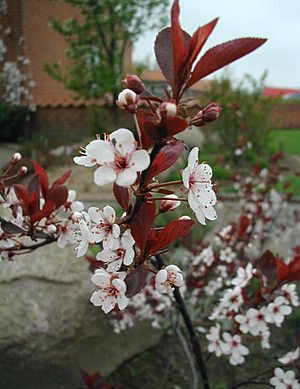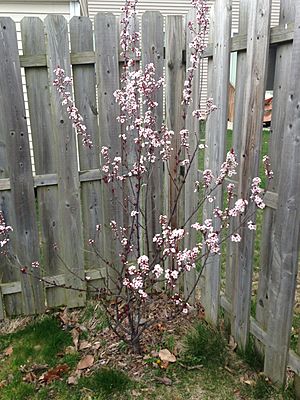Prunus × cistena facts for kids
The Purple Leaf Sand Cherry (also known as Prunus × cistena) is a special kind of plant. It's a mix of two different cherry plants: the cherry plum and the sand cherry. This plant usually grows into a bushy shrub or a small tree, reaching about 1.5 to 2.5 meters tall. It can live for 10 to 20 years.
Quick facts for kids Prunus × cistena |
|
|---|---|
 |
|
| Scientific classification | |
| Genus: |
Prunus
|
| Species: |
× cistena
|
About the Purple Leaf Sand Cherry
The purple leaf sand cherry is a hybrid plant. This means it was created by crossing two different types of plants. In this case, it's a mix of the cherry plum (Prunus cerasifera) and the sand cherry (Prunus pumila).
It often grows as a tall, thin bush or a small tree. It can reach a height of about 1.5 to 2.5 meters (about 5 to 8 feet). These plants usually live for 10 to 20 years.
Edible Fruits
The fruits of the purple leaf sand cherry are safe to eat. However, they have a very strong taste. Some people like to use them to make jams or fruit preserves. It's important to remember that you should not eat the pits (the seeds inside the fruit).
Growing Conditions
This plant is very good at handling cold weather. It can grow in places as cold as USDA Hardiness Zone 2a. This is one of the coldest plant zones.
Many purple leaf sand cherry plants you see for sale are "grafted." This means a piece of the purple leaf sand cherry is joined onto the roots of another plant. This can affect how the plant grows and how tall it gets. There are also different types, called "cultivars," which have slightly different features.
History and Awards
The purple leaf sand cherry was first created by a person named Niels Ebbesen Hansen. He developed this plant in the year 1910.
Later, in 1993, this plant received a special award. It won the Royal Horticultural Society's Award of Garden Merit. This award is given to plants that are excellent for gardening.


